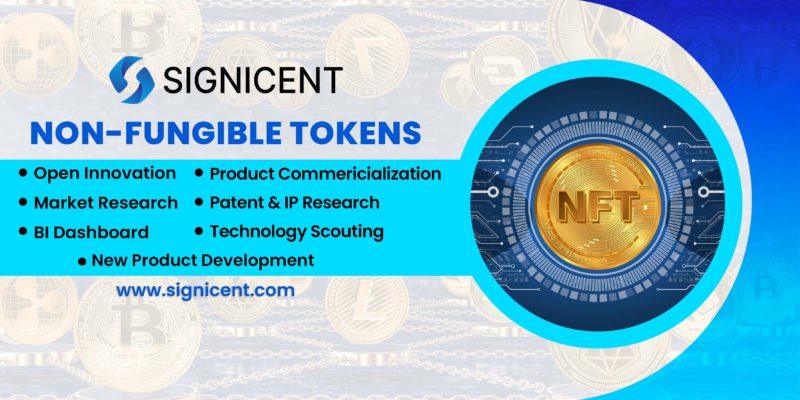The non-fungible token report will shed light on a technology intelligence study on non-fungible tokens and major players. The non-fungible tokens are broadly segmented into three categories. On the basis of type, it encompasses physical asset, digital asset, others. On the basis of application, it has collectibles, art, gaming, utilities, metaverse, sports, and others. On the basis of end-use, it has personal, commercial, and others.
Non-fungible tokens are digital assets that can be both digital and physical. The astonishing fact is that no two NFT are alike. Therefore they have made the market crazy because of blockchain. Blockchain keeps the ownership credentials safely and untampered. Traditionally foul play modification or changes in assets were possible which is not the case with blockchain.
There are a number of blockchains available, for instance, Ethereum, Free TON, Polkadot, Cosmos, etc. The first step is the creation of the wallet followed by minting NFT. Linking of the wallet is a very critical step and it is possible only after metamask registration.
Blockchain and NFTs are Inseparable
Blockchain laid the foundation for fungibility. It allows exchange for value in the terms of cryptocurrencies. Blockchain has brought non-fungibility to the digital space in the form of NFTs.
Blockchain’s susceptibility, reliability, and decentralization have created new possibilities for the flawless trading, and sharing of digital assets. Additionally, this is going to incline novel blockchain-based innovation.
Blockchain and H- Gate For Safe NFT
In this section of the non-fungible token report relationship between blockchain and non-fungible tokens has been discussed. Classical NFTs have certain limitations, such as high-power consumption for mining and less security. Since all the classical frameworks are secure due to some puzzles that are hard to fathom. A new protocol for preparing quantum non-fungible tokens is aiding the process. In this scenario, a quantum state representing NFT is mounted on a blockchain instead of physically giving it to the proprietor. And as blockchain is decentralized it is safer.
The first qubit of bell state contains information of owner and art whereas the second qubit stores information of token. To create a token that is a random and unique phase, we use a Hadamard gate. This H gate places a qubit in a superposition of zero and one.
Each year Signicent provides consultancy to hundreds of organizations to help transform their innovations to value.
Generative Adversarial Networks
Signicent regularly tracks changes in the technology and market. Our experience and understanding of the area can help better R&D, help solve the bottleneck, and take the NFT to a diverse audience.
NFTs can be incorporated into a smart contract which allows the owner to benefit from a future sale percentage. While digital art producers can benefit immensely from NFTs, their production is time-consuming. Using generative adversarial networks (GANs) for the automatic generation of digital arts can save time. GANs are deep learning architectures that are widely and effectively used for the synthesis of audio, images, and video content.
A style transfer-based model known as StyleGAN was employed for the proposed NFT arts generation application. StyleGAN is capable of generating high definition face images using two mechanisms, i.e., generating high-resolution images using progressive growing and using adaptive instance normalization to infuse image styles in each layer. To know more about non-fungible tokens, order the non-fungible tokens report.
A network that enables mapping from the latent space to a high dimensional space before adding fully connected layers to another network that synthesizes content with input noise. The results of the case study indicate that the generated samples were close to the real samples for the four evaluation characteristics.
The generated artworks scored 3.24 overall out of 5 in comparison to the slightly higher overall score of 3.35 out of 5 for the real samples.
Physically Binding IoT Devices to Smart NFT Using PUFs
Current NFTs allow representing assets by a unique identifier, as a possession of an owner. A smart NFT has physically bound to its IoT device thanks to the use of a physical unclonable function (PUF) that allows recovering its private key and, then, its BCA (Blockchain Account) address. The link between tokens and devices is difficult to break and can be traced during their lifetime because devices execute a secure boot and carry out mutual authentication processes with new owners.
The solution proposed in this non-fungible token report work guarantees the trustworthiness of the hardware and software of IoT devices from manufacturing until the end-user application. The IoT device is able to generate and recover its BCA in a trusted way from its hardware through a PUF and executes a secure boot that ensures it consults its smart NFT periodically.
The device is physically bound to its Smart NFT because the token identifier stored in its one-time programmable memory matches the device BCA address recovered and stored in the token.
Top Companies in Terms of R&D
To know company profiles, emerging technology, and revenue generated by key players of the market, request a Non-Fungible Tokens Report. Some of the innovative companies covered include Opensea, Yellowheart, Syscoin, Bitflyer, Smartvalor, Dappradar.
Recent Report
- Low Voltage Products Report: How innovations are overriding the challenges & market?
- Food Processing Technology Report: Can Technology Spark the Food Market?
- Water Treatment System Report: How Sustainability has Power to Drive Market?
- Virtual Protection Relay Report: What Market Trends Are Expected?
- Vegan Edible Collagen: How It Will Change Market & Eating Habits?


